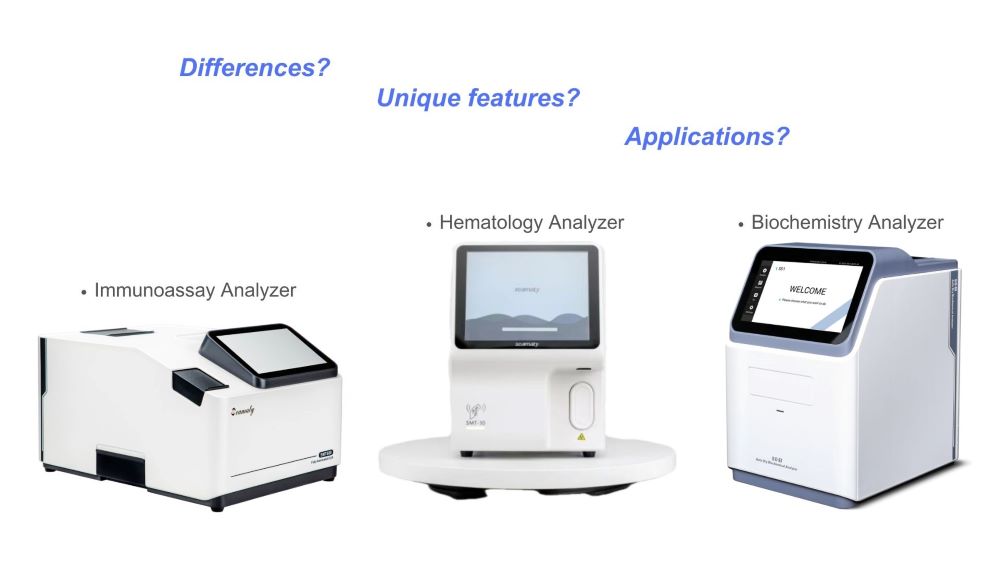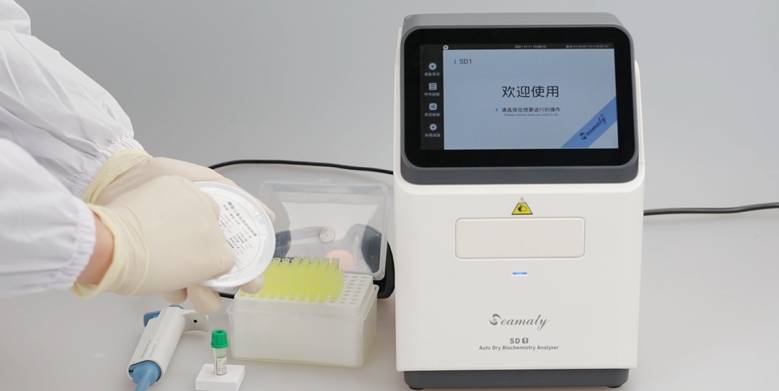release time:2023-11-29 10:58:19
In this blog post, we will delve into the nuances of biochemistry analyzers, hematology analyzers, and immunoassay analyzers, exploring their unique features, applications, and the differences that set them apart.

In the realm of diagnostic medicine, precision is paramount. Healthcare professionals rely on a variety of clinical analyzers to decipher the intricacies of a patient's health. Three such analyzers—biochemistry, hematology, and immunoassay—take center stage in the diagnostic arena, each specializing in a particular aspect of physiological analysis.
A biochemistry analyzer, also known as a clinical chemistry analyzer, is designed to examine substances within bodily fluids, providing insights into metabolic processes and organ function. This type of analyzer is a workhorse in clinical laboratories, conducting tests that measure enzymatic activities, metabolite concentrations, and electrolyte levels.
Biochemistry analyzers perform a spectrum of tests, including enzyme assays to evaluate organ function, metabolite analysis for assessing metabolic disorders, and electrolyte analysis crucial for maintaining physiological balance.
These analyzers often employ various techniques such as spectrophotometry and immunoassays to quantify substances in blood, urine, or other bodily fluids. They offer a comprehensive view of a patient's biochemistry, aiding in the diagnosis and management of conditions such as diabetes, liver diseases, and renal disorders.
Biochemistry analyzers are indispensable in routine health check-ups and the diagnosis of a wide array of medical conditions. From lipid profiles to glucose levels, these analyzers provide clinicians with essential information for formulating accurate treatment plans.
Moving beyond the realm of biochemistry, hematology analyzers focus on the cellular components of blood, offering a detailed examination of red and white blood cells as well as platelets. Their primary role is to provide a comprehensive understanding of a patient's hematological health.
Hematology analyzers conduct essential tests such as the Complete Blood Count (CBC), which assesses the quantity and quality of blood cells. Additionally, these analyzers delve into red blood cell indices, white blood cell differentials, and platelet counts, offering a nuanced view of blood composition.
Utilizing technologies like flow cytometry and impedance, hematology analyzers provide rapid and accurate results. Their ability to identify abnormalities in blood cell populations is crucial for diagnosing conditions such as anemia, leukemia, and various infections.
From routine blood tests to investigating complex hematological disorders, hematology analyzers serve as indispensable tools for healthcare professionals. The insights gained from these analyzers aid in the early detection and monitoring of blood-related diseases, facilitating timely interventions.
Stepping into the domain of immune system markers, immunoassay analyzers are designed to detect and quantify specific proteins, hormones, or antibodies in biological samples. This type of analyzer plays a pivotal role in diagnosing infectious diseases, hormonal imbalances, and certain types of cancers.
Immunoassay analyzers encompass a broad spectrum of tests, including hormone assays to measure endocrine function, infectious disease testing for detecting pathogens, and tumor marker assays crucial in cancer diagnosis and monitoring.
Employing techniques like enzyme-linked immunosorbent assay (ELISA) and chemiluminescence, immunoassay analyzers offer high sensitivity and specificity. These features are vital for accurately detecting and quantifying target molecules, even at low concentrations.
The applications of immunoassay analyzers are vast, ranging from screening for infectious diseases like HIV and hepatitis to monitoring thyroid function and detecting cardiac biomarkers. Their ability to provide precise and reliable results contributes significantly to diagnostic accuracy.
To wrap up the differences of biochemistry analyzer vs hematology analyzer vs immunoassay analyzer, you can have a more intuitive and clear understanding from the table below:
|
Aspect |
Biochemistry Analyzer |
Hematology Analyzer |
Immunoassay Analyzer |
|
Definition and Purpose |
Examines substances in bodily fluids for metabolic processes and organ function. |
Focuses on the cellular components of blood, providing insights into red and white blood cells, and platelets. |
Detects and quantifies specific proteins, hormones, or antibodies in biological samples. |
|
Types of Tests |
Enzyme assays, metabolite analysis, electrolyte analysis. |
Complete Blood Count (CBC), red and white blood cell differentials, platelet counts. |
Hormone assays, infectious disease testing, tumor marker assays. |
|
Key Features |
Measures enzymatic activities, metabolite concentrations, and electrolyte levels. |
Utilizes technologies like flow cytometry and impedance for detailed blood cell analysis. |
Uses techniques like ELISA and chemiluminescence for high sensitivity and specificity. |
|
Applications |
Aids in the diagnosis and management of conditions such as diabetes, liver diseases, and renal disorders. |
Essential for detecting and monitoring blood-related diseases, including anemia and leukemia. |
Crucial in diagnosing infectious diseases, hormonal imbalances, and certain types of cancers. |
|
Technological Advances |
Integration of automation, enhanced throughput. |
Improved precision, broader parameter range. |
Miniaturization, increased multiplexing capabilities. |
|
Challenges |
Interference from lipids or bilirubin may impact accuracy. |
Challenges in distinguishing between cell populations in cases of abnormal cell morphology. |
Sensitivity to variations in sample handling and storage may affect result reliability. |
|
Future Directions |
Integrated diagnostic platforms combining capabilities of different analyzers. |
Advancements in artificial intelligence for data interpretation and decision-making. |
Continued evolution towards more streamlined and efficient diagnostic processes. |
In recent years, the field of diagnostic analyzers has witnessed remarkable technological advancements. Biochemistry analyzers have become more sophisticated, integrating automation and enhancing throughput. Hematology analyzers now offer improved precision and a broader range of parameters, allowing for more detailed insights into blood composition. Immunoassay analyzers benefit from miniaturization and increased multiplexing capabilities, enabling simultaneous analysis of multiple analytes. These technological strides not only enhance the efficiency of diagnostic processes but also contribute to the early detection and monitoring of various health conditions.
Despite their indispensable role in healthcare, clinical analyzers are not without challenges. Biochemistry analyzers may face issues related to interference from lipids or bilirubin, affecting the accuracy of certain tests. Hematology analyzers may encounter challenges in distinguishing between cell populations in cases of abnormal cell morphology. Immunoassay analyzers may be sensitive to variations in sample handling and storage, impacting result reliability. Acknowledging these challenges is crucial for healthcare professionals to interpret results accurately and make informed clinical decisions.
The future of diagnostic analyzers holds exciting possibilities. Integrated diagnostic platforms, combining the capabilities of biochemistry, hematology, and immunoassay analyzers, are on the horizon. These platforms aim to provide a comprehensive overview of a patient's health in a streamlined and efficient manner. Artificial intelligence is also poised to play a significant role, aiding in data interpretation and decision-making. As technology continues to advance, the landscape of diagnostic medicine is likely to witness transformative changes, ultimately improving patient outcomes.
In conclusion, the trio of biochemistry, hematology, and immunoassay analyzers serves as the backbone of diagnostic medicine, offering valuable insights into a patient's health. Biochemistry analyzers unravel the mysteries of metabolic processes, hematology analyzers dissect the cellular components of blood, and immunoassay analyzers delve into the intricate world of immune markers. Understanding the unique features and applications of each type of analyzer is essential for healthcare professionals in delivering precise and effective patient care. As technology evolves, these analyzers will continue to shape the future of diagnostics, contributing to advancements in medical science and ultimately improving the quality of healthcare globally.
1. Rifai, N., Horvath, A. R., Wittwer, C. T. (Eds.). (Year). *Tietz Textbook of Clinical Chemistry and Molecular Diagnostics.* Publisher.
2. Hoffman, R., Benz, E. J., Silberstein, L. E., et al. (Year). *Hematology: Basic Principles and Practice.* Publisher.
3. Burtis, C. A., Bruns, D. E. (Year). *Tietz Fundamentals of Clinical Chemistry.* Publisher.
4. Lam, M. K. (Year). "Immunoassay Techniques in Clinical Chemistry: A Review." *Critical Reviews in Clinical Laboratory Sciences,* Volume(Issue), Page range.
5. Special Report: Desirable Standards for Hematology Tests: A Proposal (American Journal of Clinical Pathology, Volume 88, Issue 5, 1 November 1987, Pages 667–669)
6. A Strategy to Promote Rational Clinical Chemistry Test Utilization (American Journal of Clinical Pathology, Volume 103, Issue 6, 1 June 1995, Pages 718–724)

2025-02-21
Discover the Seamaty Qt3 veterinary blood chemistry analyzer, featuring an innovative dual-rotor system. Learn how this game-changing technology enhances diagnostic accuracy, efficiency, and patient care with minimal sample volume and user-friendly operation. Ideal for veterinary practices of all sizes.

2023-05-12
Learn about essential diagnostic tools for accurate diagnoses in canines and felines. Discover the benefits of using Seamaty's veterinary analyzers for reliable results.

2022-01-10
The majority of clinical biochemistry tests are now automated. Most of them are performed by fully automated biochemistry analyzers. The fully automated biochemistry analyzer is computer-controlled.